Introduction
The study of nuclide production and its properties in the N=126 neutron-rich region is of great significance for expanding the nuclear landscape, revealing the evolution of the shell structure, and understanding astrophysical nucleosynthesis. According to the theory of nuclear astrophysics, approximately half of the nuclei in nature heavier than iron are considered to be produced by a rapid neutron capture process, also known as the r-process [1-3]. The properties of N=126 neutron-rich nuclei, such as mass and lifetime, play a crucial role in understanding the r-process abundance peak around A=195 [4-6]. However, reaching this region experimentally is difficult because of the low production cross sections and the great challenge of separation and identification. The lack of experimental data leads to significant uncertainty in predicted abundance patterns [7-10]. Therefore, research on the production and properties of neutron-rich nuclei around
In recent decades, producing N=126 neutron-rich nuclei in the laboratory has become a challenging problem. Multi-nucleon transfer (MNT) reactions at near-barrier energies are expected to be powerful techniques for synthesizing and studying nuclides in the neutron-rich N=126 region [11-14]. Several facilities based on MNT reactions have been constructed or are in planning or under construction around the world, such as KISS at RIKEN [15], IGISOL at JYFL [16], the N=126 factory at ANL [17], and INCREASE at GSI [18]. Some neutron-rich isotopes of Pt, Ir, and Os, produced as target-like fragments using the 136Xe+198Pt reaction system, were successfully extracted using the KISS facility [19, 20]. However, to reduce the plasma density in a gas cell induced by the primary beam and elastic products [15, 21, 22], experiments using these facilities are typically performed at low primary beam intensities. Moreover, thin reaction targets must be used because of the low beam energies used in experiments. Low beam intensity and thin reaction targets are not beneficial for obtaining high fragment yields. To increase the available primary beam intensity, a new design using a gas-filled solenoid to suppress unwanted elastic particles has been proposed for future facilities such as NEXT at Groningen [23] and KISS-II at RIKEN [24].
Except for MNT reactions at near-barrier energies, the experimental results indicate that the projectile fragmentation reaction of 208Pb or 238U at relativistic energies may be an effective method for producing heavy neutron-rich nuclei in this region [25, 26]. However, this method requires a high beam intensity, relativistic beam energy, and high performance of the in-flight separator to be met simultaneously. A high beam intensity is necessary to produce products with low cross sections. Relativistic energy is required to reduce the number of populated ionic charge states, thereby increasing collection efficiency. High-performance separators are crucial for separating and identifying heavy neutron-rich fragments [27]. The future Super-FRS in-flight facility at FAIR [28] satisfies these conditions. Searching for new isotopes and studying their properties in the region along the N=126 line below 208Pb has been proposed as one of the main physical objectives of FAIR Phase-0 experiments [29].
High-energy FRagment Separator (HFRS) [30, 31], an in-flight separator at relativistic energies, is now under construction at the High-Intensity heavy-ion Accelerator Facility (HIAF) [32, 33] and will start operation a few years later. It is also characterized by high ion-optical acceptance, high-resolution power, high magnetic rigidity, and excellent particle identification, similar to the Super-FRS separator. In combination with the HIAF accelerator facility, which will provide beams up to 34 Tm corresponding to 238U35+ ions of 833 MeV/nucleon and with intensity as high as 1e11 ions per pulse, the neutron-rich nuclei around N=126 from projectile fragmentation at relativistic energies can be produced and purified by using the HFRS separator. This provides a new opportunity to study the properties of N=126 neutron-rich nuclei and understand the third abundance peak in the r-process.
In this study, we primarily focused on the production of N=126 neutron-rich nuclei and the feasibility of studying their properties using the HIAF-HFRS facility. Measurement methods for nuclear properties, such as mass and lifetime, as well as the layout of related experimental setups, are introduced first. Subsequently, simulation results are presented to verify its feasibility.
Experimental setups and methods
Nuclear masses and lifetimes are of fundamental importance in r-process simulations. Using the HFRS separator at the HIAF facility, some neutron-rich nuclei in the region along the N=126 line below 208Pb could be produced, and the properties of these nuclei, such as their mass and lifetime, can be experimentally measured.
The experimental setup for the HFRS separator is illustrated in Fig. 1. A relativistic 208Pb or 238U primary beam will be extracted from the HIAF accelerator facility in the slow extraction mode and implanted into the carbon production target at the entrance of the HFRS separator. The fragments of interest produced via the fragmentation reaction will be collected and separated using the Bρ-Δ E-Bρ method [34, 35], in which the analysis of magnetic rigidity (Bρ) is combined with the energy loss in an achromatic degrader (Δ E) at the pre-separator stage. An achromatic degrader will be placed on the PF2 dispersion plane. The unreacted primary beam will be intercepted in the beam dump systems installed after each dipole magnet in the pre-separator, according to Bρ deviation between the primary beam and the desired isotope.

The main separator will be used as a spectrometer. Cocktail products are identified at this stage by combining the Δ E-TOF-Bρ method and isomer-tagging technique [36-38]. The energy loss (Δ E), time of flight (TOF), and Bρ are measured and used to determine the atomic number Z and mass-to-charge ratio A/Q of each fragment. Cocktails can be unambiguously identified by detecting delayed γrays emitted from the short-lived isomeric states of certain fragments. A schematic diagram of the particle identification setup is shown in Fig. 1. Multiple sampling ionization chambers (MUSIC) placed at MF6 will be used for the Δ E measurements [39, 40]. The TOF information will be obtained using TOF detectors installed at the PF4 and MF6 foci with a flight path of 118.03 m [31, 41]. The Bρ value will be determined from position measurements at the MF4 dispersive plane. At the final focal plane of the HFRS, a decay detector array consisting of a silicon array stopper surrounded by an array of high-purity germanium detectors will be used for isomer tagging of the selected fragments.
In the Δ E-TOF-Bρ method, the mass-to-charge ratio A/Q of a fragment is determined using the following equation:
From Eqs. (3) and (4), the mass resolution σm/m of the Bρ–TOF method can be expressed as
For the TOF measurement, the lower the ion energy, the longer the flight time, which is more conducive to improving TOF measurement accuracy. However, for N=126 neutron-rich heavy nuclei, low ion energy can cause changes in the charge-state population passing through the materials placed at the foci, thereby affecting the collection efficiency. Figure 2 (a) shows the fractions of fully stripped ions in the equilibrium charge state after passing through an Al degrader for elements in the N=126 region as a function of the kinetic energy behind the degrader. This was calculated using the Global code [51]. One can observe that the fraction of fully stripped ions decreased with increasing charge number and decreasing kinetic energy. When the ion energy behind the Al degrader is greater than 350 MeV/nucleon, even for the heaviest Hg element, the proportion of fully stripped ions is greater than 50 %. This proportion is acceptable for the mass measurement experiments. The flight path length of the HFRS is 118.03 m. Figure 2 (b) shows the effect of the time resolution of the TOF system on mass measurement accuracy under different ion energies. For an ion with a kinetic energy of 350 MeV/nucleon, the contribution of TOF resolution to the final mass resolution is ~9.9×10-5 at a system resolution of ~30 ps (σ). This TOF resolution requirement is achieved experimentally. For example, at NSCL, two plastic scintillator detectors read out by photomultiplier tubes were used for the TOF measurement, and the resolution was measured to be ~30 ps (σ) with primary beam tests [52]. An upgraded TOF system for Bρ–TOF mass measurement experiments was developed at the NSCL and achieved a better time resolution (σ) of 7.5 ps [53]. In addition, two CVD diamond detectors formed the TOF system used in RIKEN mass-measurement experiments, with a system resolution of 27 ps (σ) [54].
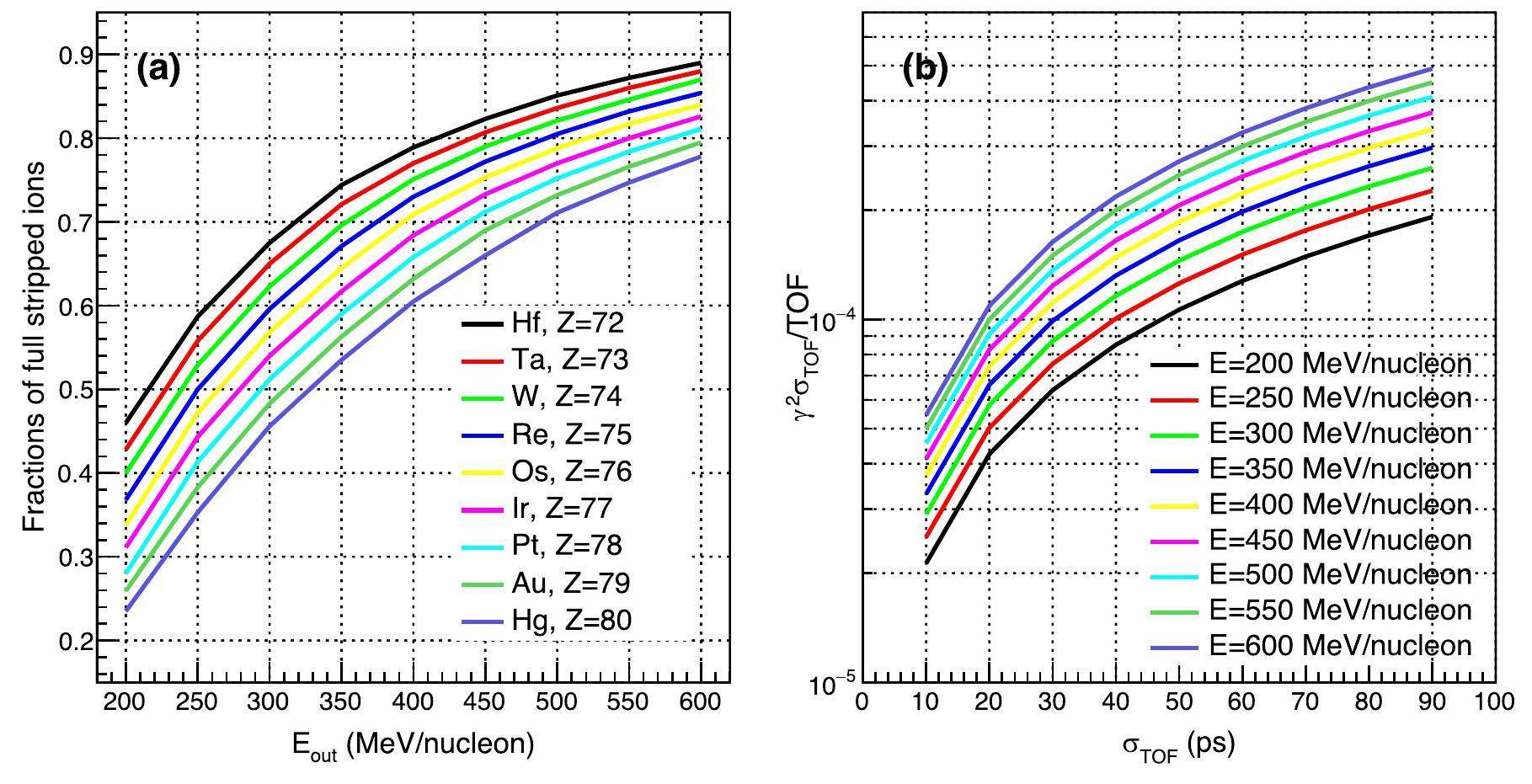
Based on the contributions of the position measurement accuracy (~9.9×10-5) and TOF measurement accuracy (~5×10-5) obtained above, the mass resolution of ~1.1×10-4 can be obtained from Eq. (5), which corresponds to
In addition, the mass shifts contributed by the isomers will be estimated from isomer measurements using the decay detector array at the final focal plane of the HFRS. The fragments will be stopped in the silicon array stopper after the mass measurement, and the germanium detectors installed close to the stopper will be used to detect isomeric
Simulation and analysis
With the HFRS separator at the HIAF facility, many neutron-rich nuclei around N=126 can be produced, and their properties, such as mass and lifetime, can be experimentally measured. This is of great significance for expanding nuclide maps, developing nuclear theories, and understanding the origins of heavy elements in the universe. In this section, we first introduce the high-resolution optical mode of the HFRS specifically developed for Bρ–TOF mass measurement experiments. The production, separation, identification, and nuclear mass measurement accuracy are then studied with the Monte Carlo simulation program MOCADI [58] using high-resolution ion optics for neutron-rich nuclei around N=126.
High resolution ion-optics
For Bρ –TOF mass measurement experiments, the pre-separator of the HFRS will be used as a separator, and the main separator will be used as a spectrometer. A high-resolution ion optics of the spectrometer is necessary to accurately measure the ion magnetic rigidities. Using parameterized magnetic field distributions [31], the high-resolution ion optics were designed using the codes of Winagile [59] and GICOSY [60]. Figure 3 shows the beam envelopes with initial beam spot sizes X=± 1 mm and Y=± 1.5 mm. To improve the momentum resolution compared with the normal mode [31], the horizontal angular acceptance is decreased to ± 5 mrad, and the momentum acceptance is reduced to ± 0.2 %. The maximum magnetic rigidity also decreases from 25 Tm to 15 Tm. The vertical angular acceptance remains unchanged at 25 mrad. The momentum-resolving powers at PF2 and MF4 are 1270 and 7440, respectively, for an emittance of 5 mm mrad and a horizontal beam spot size of ± 1 mm. The momentum dispersion at MF4 is 12 cm/%. With this dispersion, the uncertainty of
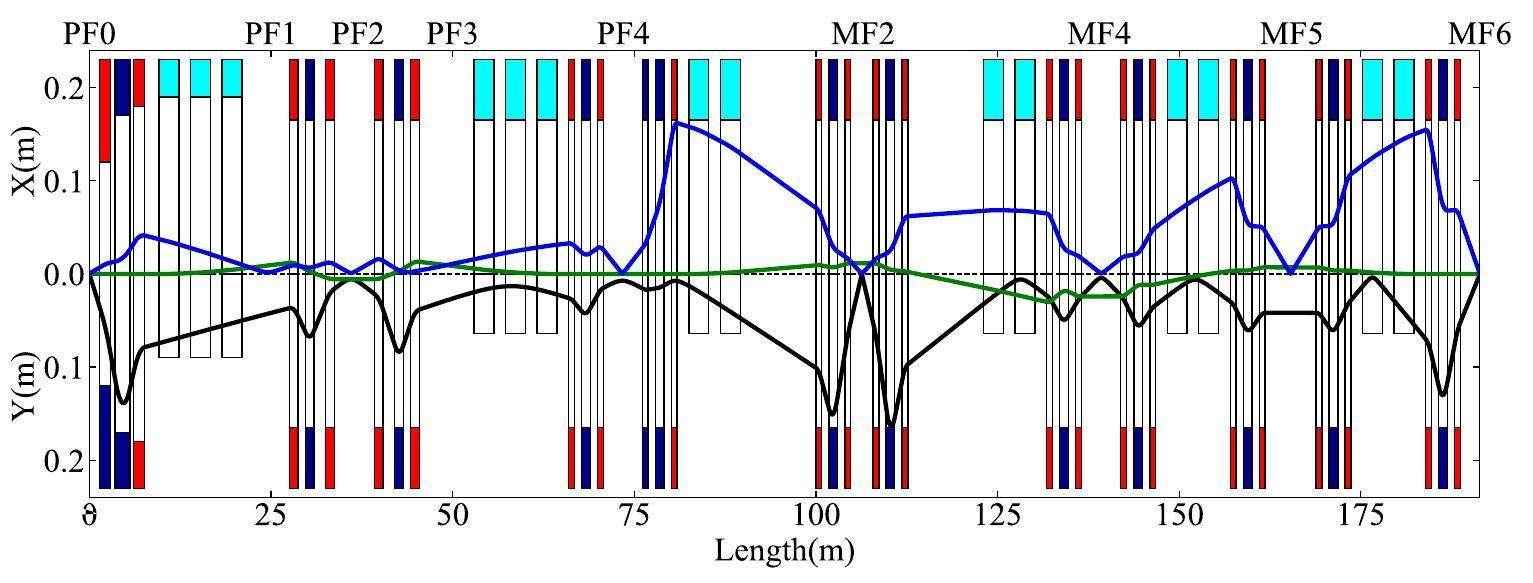
Production and separation
To produce neutron-rich nuclei around N=126 via a fragmentation reaction, the available projectiles primarily include 208Pb and 238U. Both types of projectiles were used in the simulations. For a specific nucleus of interest, the use of Pb or U fragmentation is determined based on the calculated yields. The Booster Ring (BRing) synchrotron of the HIAF facility has a maximum magnetic rigidity of 34 Tm, and can accelerate 208Pb31+ and 238U35+ ions to 850.74 and 833.15 MeV/nucleon, respectively. The beam intensities of Pb and uranium were as high as those of 1.1×1011 and 1.0×1011 ions per pulse, respectively. The typical beam extraction time in slow extraction mode was 3 s with a repetition period of 13 s. The corresponding beam spots in the X and Y directions on the production target were assumed to be Gaussian distributions with standard deviations of 0.4 mm and 0.6 mm, respectively.
Taking the production of 204Au ions as an example, the production and separation ability of neutron-rich nuclei around N=126 is simulated and studied using the high-resolution ion optics of the HFRS. In the simulation, a graphite target installed on the PF0 focal plane was used as the production target. The thickness of the graphite target was set to 4.4 g/cm2 for both Pb and U fragmentation reactions, which corresponded to 50.1 % of the Pb range and 56.5 % of the U range, respectively. In addition, 75 mg/cm2 niobium foil was placed behind the production target to achieve efficient electron stripping in both reactions. More than 75 % of the 204Au ions are fully stripped, which is important for high transmission.
To purify the fragments of interest, an achromatic Al degrader placed on the PF2 dispersive plane was used. As mentioned above, when the ion energy behind the Al degrader is greater than 350 MeV/nucleon, the fraction of fully stripped ions is higher than 50 % for neutron-rich nuclei around N=126. Therefore, the thickness of the degrader was optimized such that the energy of the fragments of interest was greater than 350 MeV/nucleon. The center thickness of the Al degrader was set to 44 % and 36.8 % of the 204Au range for the Pb and U fragmentation reactions, respectively. This thickness combination of the production target and degrader ensures that the 204Au ion has approximately 356 MeV/nucleon of kinetic energy after passing through the degrader. The Global calculations show that the proportion of fully stripped 204Au ions at this energy is as high as 57 %. Considering the proportion of fully stripped ions, the HFRS magnetic rigidity was set according to the fully stripped ions in both reactions.
Figure 4 shows the simulated transmissions of the 204Au fragment from the Pb and U fragmentation reactions as functions of the separator length. A significant decrease is observed near PF1 and PF2. This is primarily caused by momentum deviation. At the PF2 focal plane, the momentum slits were set to allow fragments with ± 0.2 % momentum deviation to pass through. In addition, the transmission of the 204Au fragments produced by U fragmentation exhibits a greater reduction than that of Pb fragmentation owing to the larger momentum deviation. This is because in the U fragmentation reaction, more nucleons need to be eliminated to produce 204Au, which results in a greater momentum deviation of 204Au fragments according to the Goldhaber model [61]. The opening of the mass slits placed at the PF4 focal plane can be adjusted based on the desired transmission and the number of nuclei required for mass measurements. In the simulations, the mass slits were set to ± 5 mm. They also cause a decrease in the transmission owing to the charge-state population of the fragments. In the final focal plane, the transmission of 204Au ions is 7 % and 2 % for Pb and U fragmentation, respectively. These transmissions are significantly lower than those under the normal optical modes described in Ref. [31] primarily because of the lower momentum and horizontal angular acceptances of the high-resolution optical mode.
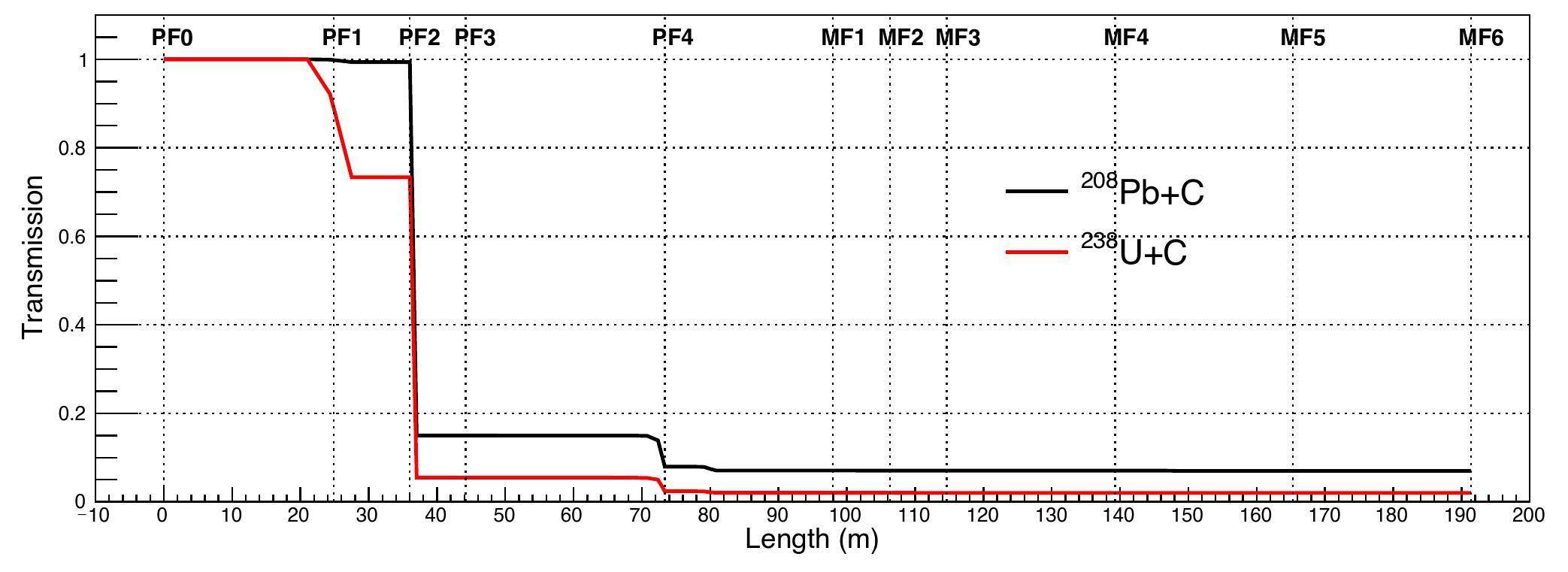
The yields and purities of the 204Au ions produced from the Pb and U fragmentation reactions were estimated and are shown in Fig. 5 (a) and (b). The area of the isotopes in the

Using the calculated cross-sections and simulated transmissions, the yields of the neutron-rich nuclei around N=126 are estimated, as shown in Fig. 6. In the estimations, the primary beam, production target, and settings of the HFRS are similar to examples of the production and purification of 204Au ions. The production cross-sections were calculated using the FRACS formula. Based on the aforementioned simulation results, the transmission of fragments from the Pb and U fragmentation reactions was fixed at 7 % and 2 %, respectively. This figure presents the results of a 5-day experiment, showing the maximum yields of the fragments of interest produced through the fragmentation reactions of Pb or U. Many new neutron-rich nuclei approaching the r-process could be produced for the first time, along with a substantial yield of neutron-rich nuclei with unknown masses and lifetimes. This indicates that the HIAF-HFRS facility has great potential for research on the production and properties of neutron-rich nuclei around N=126.
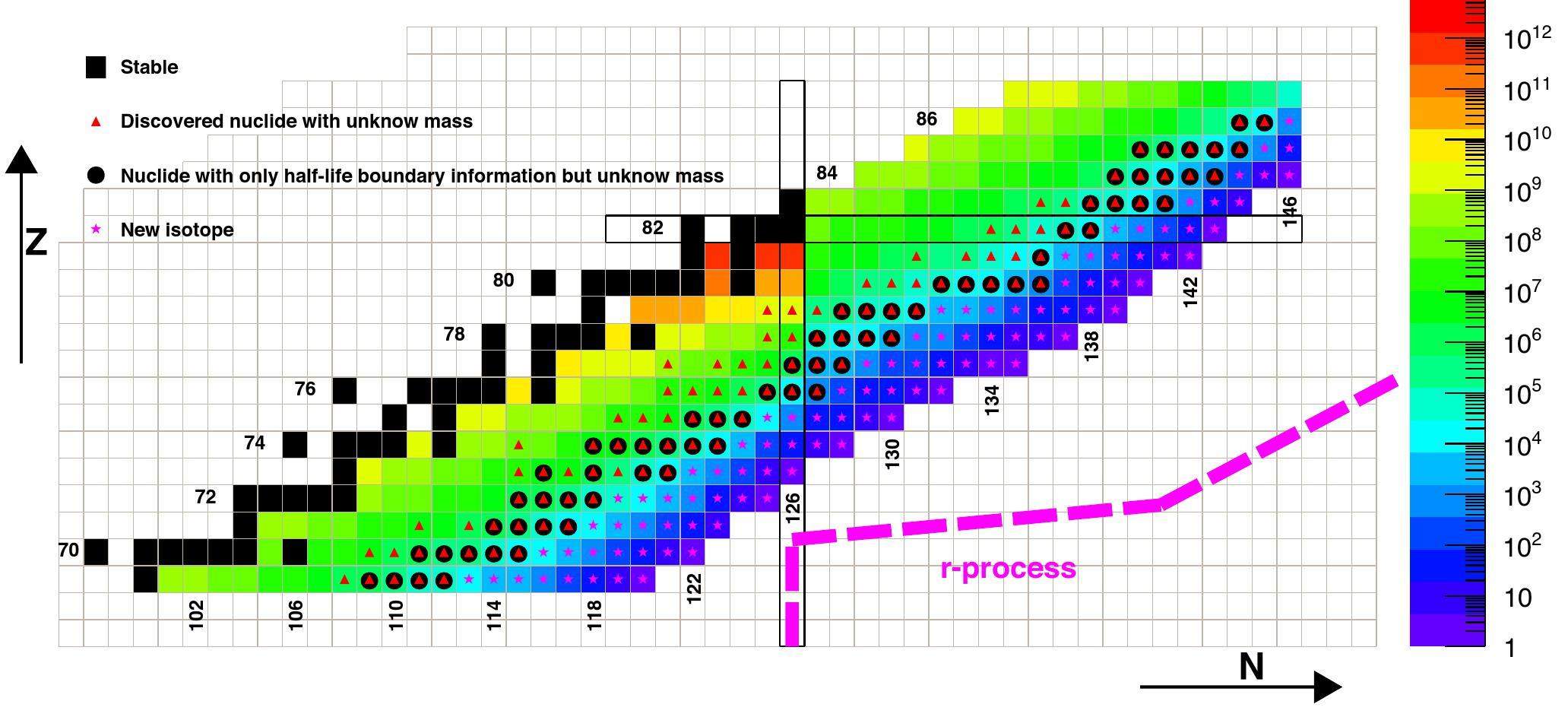
Identification and mass measurement
Taking the production of 204Au ions by Pb fragmentation as an example, the particle identification and accuracy of the mass measurement using the Bρ –TOF method will be studied in this section.
As mentioned above, the particle identification will be achieved using the Δ E–TOF–Bρ method. In the simulation, the influence of the material thickness of TOF and position detectors on ion transmission and identification was ignored. This is because they have a thinner thickness compared to the range of the fragments of interest. The thickness of the MUSIC energy-loss detector was equivalent to that of 300 μm-thick silicon. The time resolution (σ) of the TOF system was assumed to be 30 ps. The position resolution (σ) of the position detector in the dispersive plane and the energy resolution (σ) of the Δ E detector were set to 0.5 mm and 0.4 %, respectively. To obtain unambiguous particle identification, it is essential to correct the TOF values using the measured dispersive position information at the MF4 focal plane. This eliminates the magnetic rigidity dependence from the measured TOF spectra. A two-dimensional correlation between TOF and the horizontal position x in the MF4 dispersion plane for the Au isotopes is shown in Fig. 7(a). For all nuclides, the deviation between their TOF and the central time-of-flight TOF0 can be corrected using a linear function of the dispersive position x:
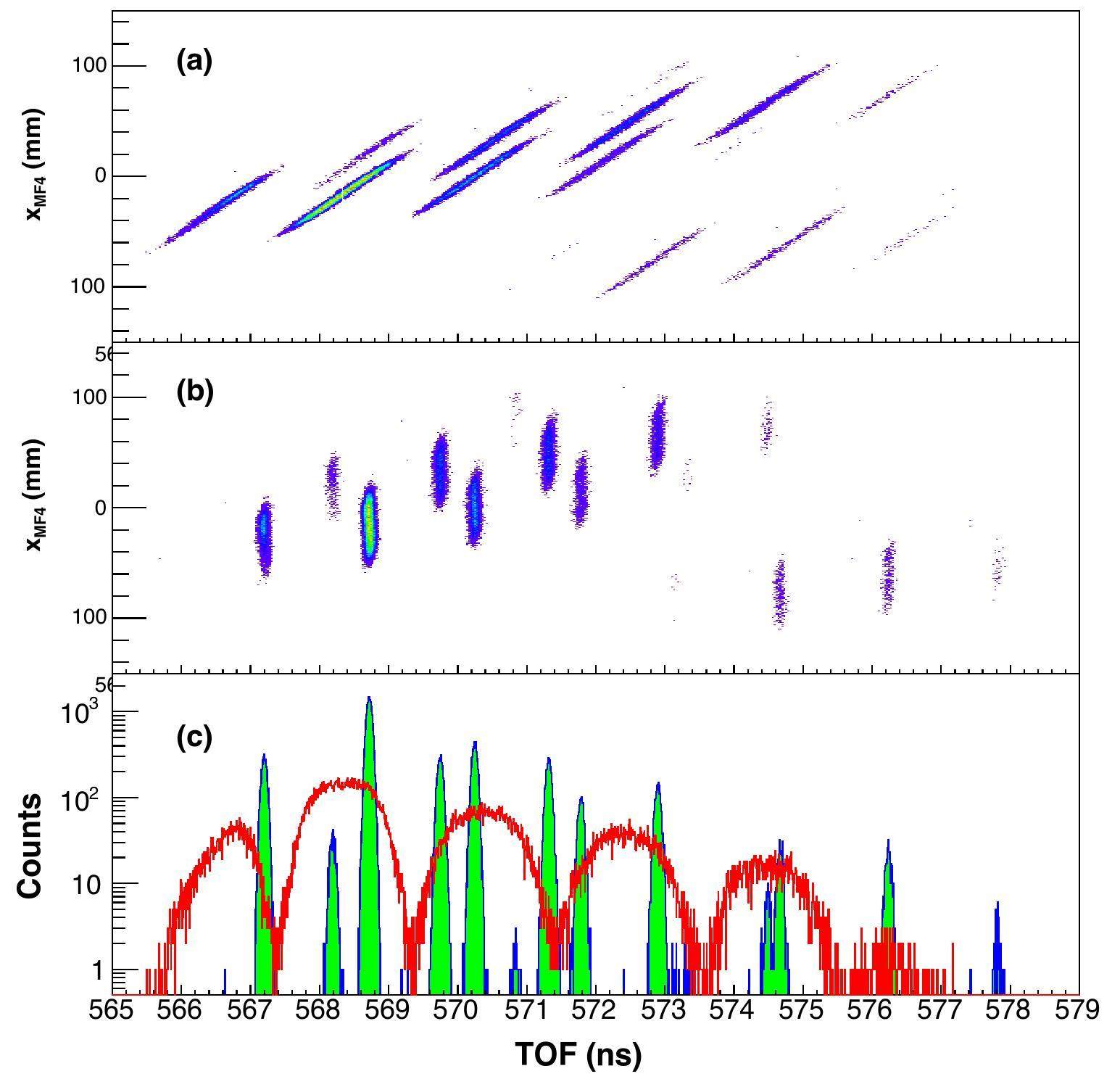
The two-dimensional correlation spectrum of the measured Δ E and corrected TOF can provide unambiguous particle identification, as shown in Fig. 8. The cocktails are unambiguously identified using an isomer-tagging method. In this experimental setting, the charge states between the fully stripped ions and helium-like ions are observed. As the fragments of interest are around
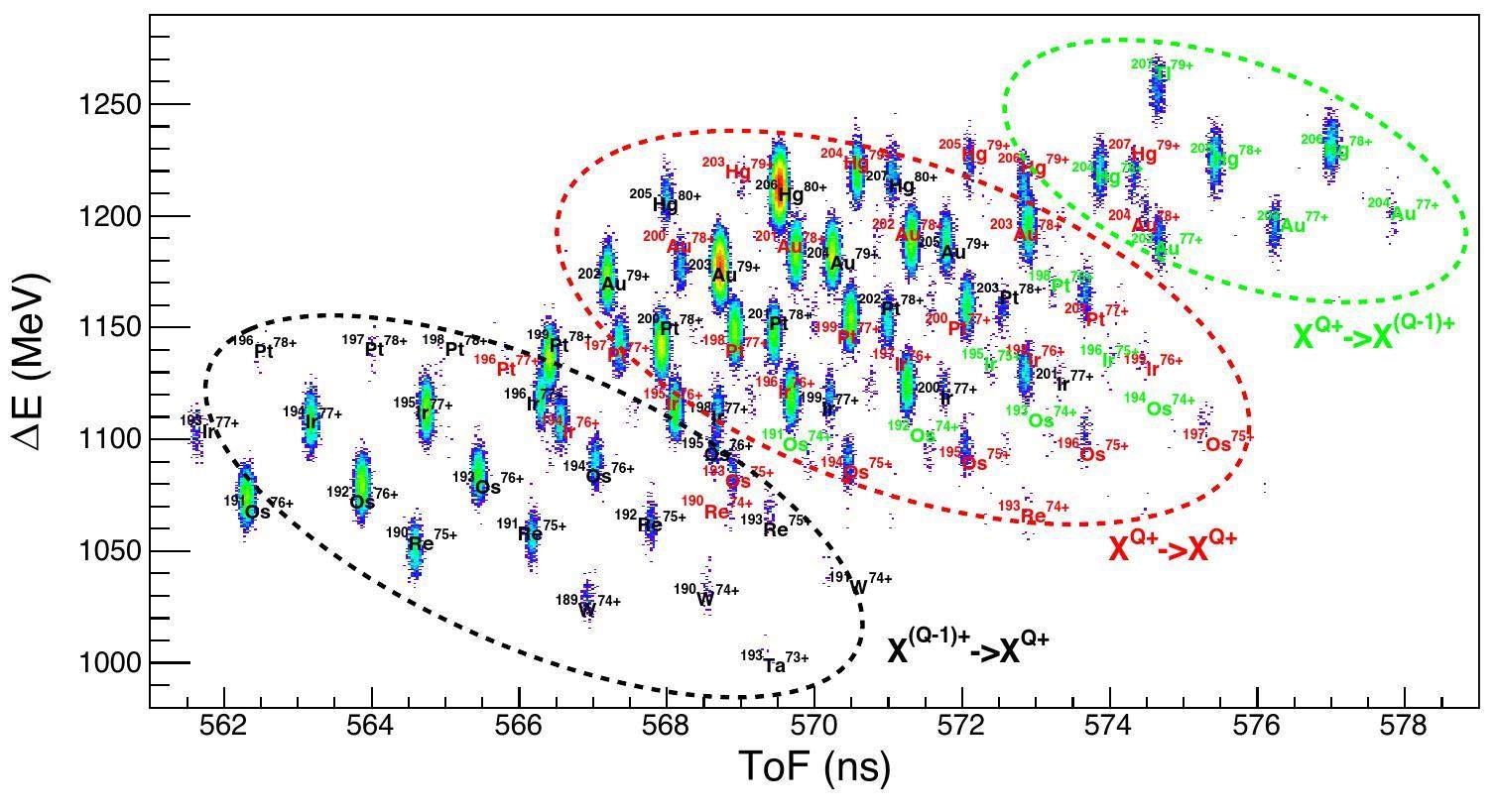
Using the obtained particle identification spectra, we will study the mass measurement precision of the neutron-rich nuclei around N=126 using the Bρ–TOF method on the HFRS. The data analysis methodology is consistent with that described in Refs. [64, 65]. Typically, nuclei with known masses are used to calibrate the relationship between time-of-flight and mass-to-charge ratios. This can help remove many uncertainties in mass measurement experiments. Among the identified cocktails, ten fully stripped nuclides with well-known masses, according to the 2012 Atomic Mass Evaluation (AME2012) [66], were selected as calibrants. In addition, these chosen nuclides have only known isomers with excitation energies below 454 keV, which corresponds to the typical mass accuracy obtained using the Bρ -TOF technique. The calibrants and their atomic mass excess values with uncertainties are listed in the left-hand columns of Table 1. The right-hand columns of Table 1 list the nuclides to be measured and their mass excess values obtained from the literature [66].
| Calibration nuclides | Nuclides to be measured | ||||
|---|---|---|---|---|---|
| Isotope | AME2012 (keV) | σm (keV) | Isotope | AME2012 (keV) | σm (keV) |
| 194Os | -32437.2 | 2.78 | 198Ir# | -25821# | 196# |
| 195Osm | -29511.6 | 60.55 | 200Ir# | -21611# | 196# |
| 196Os | -28278.8 | 10.06 | 201Ir# | -19897# | 196# |
| 196Irm | -29437.9 | 38.42 | 202Pt | -22692.1 | 25.15 |
| 197Irm | -28265.8 | 20.12 | 203Pt# | -19627# | 196# |
| 199Ir | -24400.2 | 41.06 | 203Au | -23143.5 | 3.08 |
| 199Ptm | -27390.4 | 2.22 | 204Au# | -20650# | 200# |
| 200Pt | -26600.9 | 20.12 | 205Au# | -18770# | 196# |
| 201Pt | -23740.9 | 50.1 | |||
| 202Au | -24353.0 | 23.29 | |||
The nuclear mass m can be determined from the corresponding atomic mass ma using the following formula:
After obtaining the fit parameters, the masses of these measured nuclides were calculated from the corresponding time-of-flight centroids using Eq. (9) as follows: The total uncertainties in the mass results mainly included statistical, fitting, and systematic uncertainties. The statistical uncertainty can be estimated using Eq. (11). The fitting uncertainty σfit originates from the uncertainty in the calibration function parameters. This was calculated from the error propagation based on Eq. (9),
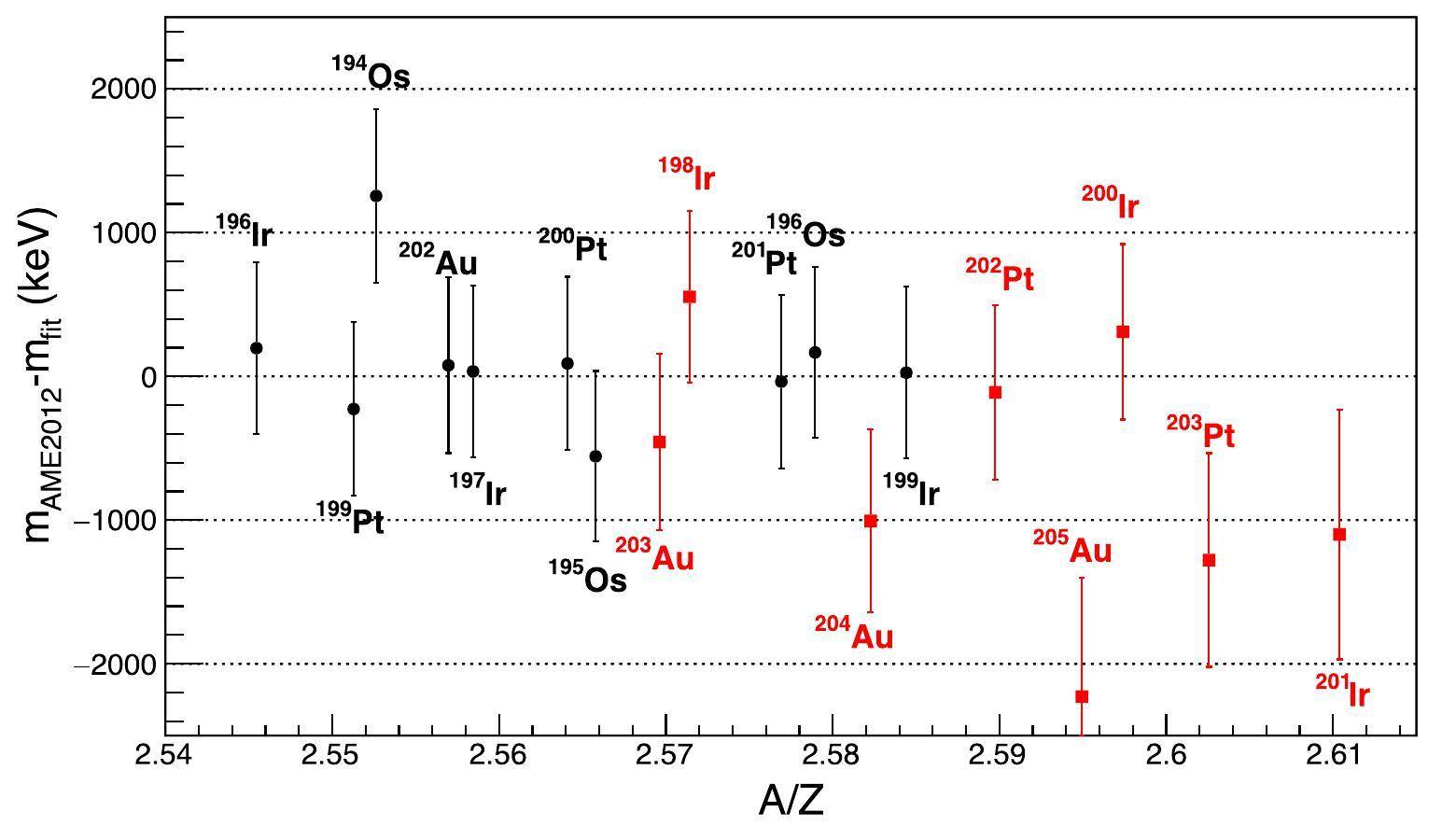
| Isotope | mfit (keV) | σtotal (keV) | Uncertainties | ||
|---|---|---|---|---|---|
| σstat (keV) | σfit (keV) | σsys (keV) | |||
| 194Os | -33701.6 | 606.26 | 106.78 | 104.37 | 587.59 |
| 195Osm | -28961.5 | 593.94 | 77.02 | 39.7 | 587.59 |
| 196Os | -28447.8 | 595.61 | 91.99 | 32.14 | 587.59 |
| 196Irm | -29637.7 | 598.31 | 26.19 | 53.73 | 595.32 |
| 197Irm | -28296.1 | 595.85 | 22.64 | 10.88 | 595.32 |
| 199Ir | -24435.8 | 596.86 | 41.33 | 11.57 | 595.32 |
| 199Ptm | -27171.2 | 603.37 | 12.0 | 15.49 | 603.05 |
| 200Pt | -26692.6 | 603.15 | 8.94 | 6.25 | 603.05 |
| 201Pt | -23709.1 | 603.23 | 12.98 | 6.77 | 603.05 |
| 202Au | -24438.1 | 611.98 | 7.84 | 37.54 | 610.78 |
| 198Ir# | -26374.9 | 596.01 | 28.11 | 11.87 | 595.32 |
| 200Ir# | -21921.2 | 611.06 | 61.41 | 123.38 | 595.32 |
| 201Ir# | -18796.2 | 868.45 | 118.62 | 621.08 | 595.32 |
| 202Pt | -22580.8 | 608.4 | 19.88 | 78.02 | 603.05 |
| 203Pt# | -18348.8 | 743.61 | 35.16 | 433.65 | 603.05 |
| 203Au | -22687.2 | 613.34 | 3.65 | 55.82 | 610.78 |
| 204Au# | -19643.5 | 635.88 | 5.96 | 176.81 | 610.78 |
| 205Au# | -16541.0 | 827.99 | 10.64 | 558.92 | 610.78 |
Summary
The properties of N=126 neutron-rich nuclei play a crucial role in developing nuclear theories and understanding the r -process abundance peak around A=195. To produce these neutron-rich nuclei while measuring their mass and lifetime, an experimental scheme has been proposed based on the HIAF-HFRS facility, and the feasibility of this scheme was evaluated through simulations in this study.
In these studies, a high-resolution optical mode for the HFRS was developed. It has a large momentum dispersion of 12 cm/% at the MF4 dispersive plane, which is beneficial for improving the accuracy of magnetic rigidity measurements in Bρ -TOF mass measurement experiments. In this high-resolution optical mode, the yields of neutron-rich nuclei around N=126 produced from the 208Pb or 238U fragmentation reactions were estimated using the FRACS formula and simulated transmissions. The results show that many new neutron-rich nuclei approaching the r-process abundance peak around A=195 can be produced for the first time, and many nuclei with unknown masses and lifetimes can be produced with high statistics. Moreover, using the time-of-flight corrected by the measured dispersive position information and energy loss information, the cocktails produced from the 208Pb fragmentation can be unambiguously identified, and the masses of some neutron-rich nuclei around N=126 can be measured with an accuracy better than 900 keV using the Bρ -TOF technique. Using this new mass data combined with machine learning based on the Bayesian neural network, as described in Refs. [7, 8], the nuclear mass of this region can be accurately predicted, which is crucial for understanding the r-process abundance peak around A=195. These simulation results indicate that the HIAF-HFRS facility can provide an opportunity for the production and property research of neutron-rich nuclei around N=126.
Currently, the HIAF-HFRS facility is under construction. All devices, including magnets, vacuum, power supplies, targets, degraders, detectors, etc., are expected to be completed and tested by the end of 2024, after which they can be installed on-site. Meanwhile, some high-performance detectors for TOF and position measurements used in Bρ -TOF mass measurement experiments have been proposed. For example, a plastic scintillator detector coupled with multiple photomultiplier tube readouts and a diamond detector are being developed for time measurement, and a position-sensitive microchannel plate detector with a large active area is being developed for position measurement. These conditions may ensure the performance of future property research experiments of neutron-rich nuclei around N=126.
Underground laboratory JUNA shedding light on stellar nucleosynthesis
. Nucl. Sci. Tech. 34, 42 (2023). https://doi.org/10.1007/s41365-023-01196-1Research program of nuclear astrophysics based on the HIAF
. Sci. Sinica Physica, Mechanica Astronomica 50, 112007 (2020). https://doi.org/10.1360/SSPMA-2020-0281Annual review of the advances in nuclear physics
. Sci. Technol. Rev. 41, 14 (2022). https://doi.org/10.3981/j.issn.1000-7857.2023.01.002 (in Chinese)Investigation of β- decay half life and delayed neutron emission with an uncertainty analysis
. Nucl. Sci. Tech. 34, 9 (2023). https://doi.org/10.1007/s41365-022-01153-4Exploring the uncertainties in theoretical predictions of nuclear β -decay half-lives
. Chinese Phys. C 45, 044103 (2021). https://doi.org/10.1088/1674-1137/abdf42β--decay half-lives for waiting point nucleiaround N=82
. Acta Phys. Sin. 63, 162301 (2014). https://doi.org/10.7498/aps.63.162301Predictions of nuclear β -decay half-lives with machine learning and their impact on r-process nucleosynthesis
. Phys. Rev. C 99, 064307 (2019). https://doi.org/10.1103/PhysRevC.99.064307Nuclear mass predictions with machine learning reaching the accuracy required by r-process studies
. Physical Review, C 106, L021303 (2022). https://doi.org/10.1103/PhysRevC.106.L021303Sensitivity Study of r-process Abundances to Nuclear Masses
. Astrophysical J. 915 29 (2021). https://doi.org/10.3847/1538-4357/ac042fInfluence of nuclear physics inputs and astrophysical conditions on r-process
. SCIENCE CHINA Physics, Mechanics & Astronomy 62, 982011 (2019). https://doi.org/10.1007/s11433-018-9355-yMulti-nucleon transfer dynamics in nearly symmetric nuclear reactions
. Nucl. Sci. Tech. 31, 59 (2020). https://doi.org/10.1007/s41365-020-00770-1Production mechanism of neutron-rich nuclei around N=126 in the multi-nucleon transfer reaction 132Sn+208Pb
. Chinese Physics C 42, 104105 (2018). https://doi.org/10.1088/1674-1137/42/10/104105Production of neutron-rich actinide isotopes in isobaric collisions via multi-nucleon transfer reactions
. Nucl. Sci. Tech. 34, 160 (2023). https://doi.org/10.1007/s41365-023-01314-zOptimal detection angles for producing N=126 neutron-rich isotones in multi-nucleon transfer reactions
. Phyiscal Review Research 5, L022021 (2023). https://doi.org/10.1103/PhysRevResearch.5.L022021Doughnut-shaped gas cell for KEK Isotope Separation System
. Nucl. Instrum. Methods. Phys. Res. B 412, 11 (2017). https://doi.org/10.1016/j.nimb.2017.08.037Production of Exotic Nuclei via MNT Reactions Using Gas Cells
. Acta Phys. Pol. B 51, 817 (2020). https://doi.org/10.5506/APhysPolB.51.817The N=126 factory: A new facility to produce very heavy neutron-rich isotope
. Nucl. Instrum. Methods. Phys. Res. B 463, 258 (2020). https://doi.org/10.1016/j.nimb.2019.05.024SINCREASE: An in-cell reaction system for multi-nucleon transfer and spontaneous fission at the FRS ion catcher
. Nucl. Instrum. Methods. Phys. Res. B 512, 83 (2022). https://doi.org/10.1016/j.nimb.2021.11.018In-gas-cell laser resonance ionization spectroscopy of 196,197,198Ir
. Rhys. Rev. C 102, 054307 (2020). https://doi.org/10.1103/PhysRevC.102.054307In-gas-cell laser ionization spectroscopy of 194,196Os isotopes by using a multireflection time-of-flight mass spectrograph
. Rhys. Rev. C 102, 034309 (2020). https://doi.org/10.1103/PhysRevC.102.034309Intensity limitations of a gas cell for stopping, storing and guiding of radioactive ions
. Nucl. Instrum. Methods. Phys. Res. B 187, 535 (2002). https://doi.org/10.1016/S0168-583X(01)01152-1Monte-Carlo simulation of ion distributions in a gas cell for multi-nucleon transfer reaction products at LENSHIAF spectrometer
. Nucl. Instrum. Methods. Phys. Res. B 463, 528 (2020). https://doi.org/10.1016/j.nimb.2019.02.013The NEXT Project: Towards Production and Investigation of Neutron-Rich Heavy Nuclides
. Atoms 10(2), 59 (2022). https://doi.org/10.3390/atoms10020059Design report of the KISS-II facility for exploring the origin of uranium
. arXiv:2209.12649Discovery and cross-section measurement of neutron-rich isotopes in the element range from neodymium to platinum with the FRS
. Phys. Lett. B 717, 371 (2012). https://doi.org/10.1016/j.physletb.2012.09.021Produced cross sections of heavy neutron-rich nuclei approaching the nucleosynthesis r-process path around A=195
. Phys. Rev. C 89, 024616 (2014). https://doi.org/10.1103/PhysRevC.89.024616Nuclear fragments in projectile fragmentation reactions
. Prog. Part. Nucl. Phys. 121, 103911 (2021). https://doi.org/10.1016/j.ppnp.2021.103911Ion-optical developments tailored for experiments with the Super-FRS at FAIR
. Nucl. Instrum. Methods. Phys. Res. B 491, 38 (2021). https://doi.org/10.1016/j.nimb.2021.01.004The science case of the FRS Ion Catcher for FAIR Phase-0
. Hyperfine Interaction 240, 73 (2019). https://doi.org/10.1007/s10751-019-1597-4Ion-optical design of High energy FRagment Separator (HFRS) at HIAF
. Nucl. Instrum. Methods. Phys. Res. B 469, 1 (2020). https://doi.org/10.1016/j.nimb.2020.02.026Ion-optical updates and performance analysis of High energy FRagment Separator (HFRS) at HIAF
. Nucl. Instrum. Methods. Phys. Res. B 547, 165214 (2024). https://doi.org/10.1016/j.nimb.2023.165214High Intensity heavy ion Accelerator Facility (HIAF) in China
. Nucl. Instrum. Methods. Phys. Res. B 317, 263 (2013). https://doi.org/10.1016/j.nimb.2013.08.046Evaluation of radiation environment in the target area of fragment separator HFRS at HIAF
. Nucl. Sci. Tech. 29, 147 (2018). https://doi.org/10.1007/s41365-018-0479-9The momentum-loss achromat — a new method for the isotopical separation of relativistic heavy ions
. Nucl. Instrum. Methods. Phys. Res. A 260, 287 (1987). https://doi.org/10.1016/0168-9002(87)90092-1Towards the full realization of the RIBLL2 beam line at the HIRFL-CSR complex
. Science Bulletin 63 78 (2018). https://doi.org/10.1016/j.scib.2017.12.005Experimental study of intruder components in light neutron-rich nuclei via a single nucleon transfer reaction
. Nucl. Sci. Tech. 31, 20 (2020). https://doi.org/10.1007/s41365-020-0731-yA new measurement of the intruder configuration in 12Be
. Physics Letters B 781, 412 (2018). https://doi.org/10.1016/j.physletb.2018.04.016First observation of a shape isomer and a low-lying strongly-coupled prolate band in neutron-deficient semi-magic 187Pb
. Physics Letters B 829, 137129 (2022). https://doi.org/10.1016/j.physletb.2022.137129A multiple sampling ionization chamber for the External Target Facility
. Nucl. Instrum. Methods. Phys. Res. A 795, 389 (2015). https://doi.org/10.1016/j.nima.2015.06.022A Longitudinal Field Multiple Sampling Ionization Chamber for RIBLL2
. Nuclear Physics Review 29 72 (2012). https://doi.org/10.11804/NuclPhysRev.29.01.072Electrostatic-lenses position-sensitive TOF MCP detector for beam diagnostics and new scheme for mass measurements at HIAF
. Nucl. Sci. Tech. 30, 152 (2019). https://doi.org/10.1007/s41365-019-0676-1Mass measurement of light neutron-rich fragmentation products
. Phys. Lett. B 176, 317 (1986). https://doi.org/10.1016/0370-2693(86)90171-1A new Time-of-Flight mass measurement project for exotic nuclei and ultra-high precision detector development
. EPJ Web of Conferences 109, 04008 (2016). https://doi.org/10.1051/epjconf/201610904008Improving the Particle Identification of Radioactive Isotope Beams at the RIBLL2 Separator
. Nuclear Physics Review 39, 65 (2022). https://doi.org/10.11804/NuclPhysRev.39.2021035Mass Measurements Demonstrate a Strong N=28 Shell Gap in Argon
. Phys. Rev. Lett. 114, 022501 (2015). https://doi.org/10.1103/PhysRevLett.114.022501Mass Measurement of 56Sc Reveals a Small A=56 Odd-Even Mass Staggering, Implying a Cooler Accreted Neutron Star Crust
. Phys. Rev. Lett. 115, 162501 (2015). https://doi.org/10.1103/PhysRevLett.115.162501Magic Nature of Neutrons in 54Ca: First Mass Measurements of 55–57Ca
. Phys. Rev. Lett. 121, 022506 (2018). https://doi.org/10.1103/PhysRevLett.121.022506Mapping of a New Deformation Region around 62Ti
. Phys. Rev. Lett. 125, 122501 (2020). https://doi.org/10.1103/PhysRevLett.125.122501Tracking rare-isotope beams with microchannel plates
. Nucl. Instrum. Methods. Phys. Res. A 795, 325 (2015). https://doi.org/10.1016/j.nima.2015.05.070Delay-line PPAC for high-energy light ions
. Nucl. Instrum. Methods. Phys. Res. A 470, 562 (2001). https://doi.org/10.1016/S0168-9002(01)00804-XCharge states of relativistic heavy ions in matter
. Nucl. Instrum. Methods. Phys. Res. B 142, 441 (1998). https://doi.org/10.1016/S0168-583X(98)00244-4Time-of-flight mass measurements of neutron-rich chromium isotopes up to N=40 and implications for the accreted neutron star crust
. Phys. Rev. C 93, 035805 (2016). https://doi.org/10.1103/PhysRevC.93.035805Plastic scintillation detectors for time-of-flight mass measurements
. Nucl. Instrum. Methods. Phys. Res. A 974, 164199 (2020). https://doi.org/10.1016/j.nima.2020.164199Development of CVD diamond detector for time-of-flight measurements
. Nucl. Instrum. Methods. Phys. Res. B 317, 710 (2013). https://doi.org/10.1016/j.nimb.2013.08.055Recent trends in the determination of nuclear masses
. Rev. Mod. Phys. 75, 1021 (2003). https://doi.org/10.1103/RevModPhys.75.1021The DESPEC setup for GSI and FAIR
. Nucl. Instrum. Methods. Phys. Res. B 1033, 166662 (2022). https://doi.org/10.1016/j.nima.2022.166662Beta-gamma spectroscopy at RIBF
. Prog. Theor. Exp. Phys. 2012, 03C006 (2012). https://doi.org/10.1093/ptep/pts078MOCADI, a universal Monte Carlo code for the transport of heavy ions through matter within ion-optical systems
. Nucl. Instrum. Methods. Phys. Res. B 126, 284 (1997). https://doi.org/10.1016/S0168-583X(97)01097-5AGILE, A Tool for Interactive Lattice Design
. Proc. of EPAC. 2000, 1357 (2000). https://www.isa.au.dk/accfys/Download/WinAgile4_release13.zipPrinciples of GIOS and COSY
. AIP Conf. Proc. 177, 74 (1988). https://doi.org/10.1063/1.37817Statistical models of fragmentation processes
. Phys. Lett. B 53, 306 (1974). https://doi.org/10.1016/0370-2693(74)90388-8Improved empirical parameterization for projectile fragmentation cross sections
. Phys. Rev. C 95, 034608 (2017). https://doi.org/10.1103/PhysRevC.86.014601The NUBASE2020 evaluation of nuclear physics properties
. Chinese Phys. C 45, 030001 (2021). https://doi.org/10.1088/1674-1137/abddaeStudy of Mass-measurement Method for N=Z Nuclei with Isochronous Mass Spectrometry
. Nuclear Physics Review 36 294 (2019). https://doi.org/10.11804/NuclPhysRev.36.03.294Direct mass measurements of neutron-rich 86Kr projectile fragments and the persistence of neutron magic number N=32 in Sc isotopes
. Chinese Physics C 39, 104001 (2015). https://doi.org/10.1088/1674-1137/39/10/104001The Ame2012 atomic mass evaluation
. Chinese Phys. C 36, 1287 (2012). https://doi.org/10.1088/1674-1137/36/12/002Recent trends in the determination of nuclear masses
. Review of Modern Physics 75, 1021 (2003). https://doi.org/10.1103/RevModPhys.75.1021ROOT: analyzing petabytes of data, scientifically
. http://root.cern.chThe authors declare that they have no competing interests.


